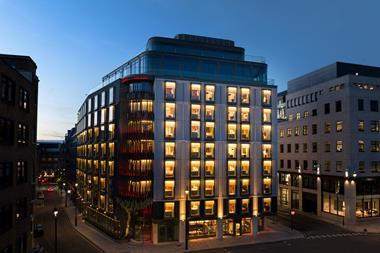Property investors are moving deeper into Europe and increasingly into alternative sectors and development, according to the latest Emerging Trends in Real Estate Europe report.
Property investors are moving deeper into Europe and increasingly into alternative sectors and development, according to the latest Emerging Trends in Real Estate Europe report.
Property investors in Europe are switching to a more granular approach to investment selection. Rather than selecting assets based on the country in which they are located, they are focusing instead on individual cities - or even particular city quarters - and assets, according to Emerging Trends in Real Estate® Europe 2016: Beyond the Capital, the annual report published jointly by the Urban Land Institute (ULI) and PwC. The change in tack is in response to 'ground-level disruptions', which the report lists as the rapidly changing demands of occupiers and the disruptive forces of technology, demographics, social change, and rapid urbanisation, all of which are 'permeating the European real estate value chain’, the report says.
And, more investors are now showing interest in alternative sectors such as healthcare, hotels, student accommodation and data centres. The report says that 41% of survey respondents would consider investing in alternative sectors, compared to just 28% in last year’s survey. Investors are also ready to raise the level of risk that they will accept in order to undertake development. Their reasoning is to extract more value out of property as the quest for suitable investments is still more competitive owing to low interest rates and the weight of capital boosting the popularity of property. The demand for investments is applying pressure to the supply of suitable stock and around 78% of the ULI/PWC survey's respondents now see development as an attractive way to acquire prime assets.
'Investors are getting more creative in trying to access future prime assets at reasonable prices through more focus on alternatives and development,' said ULI Europe CEO Lisette van Doorn. 'They are taking more risk in the short term to fulfil their long-term objective for core assets.'
Among the (anonymous) institutional investors quoted in the report, one said: 'With prices so high you have to look at where you can develop to find adequate returns. The markets for income-producing real estate are pretty fully priced so you want to be creating assets that you can sell into that market.'
It is apparent that investors are not just 'dipping their toes' either and the report notes that global investors are taking on development projects, and in some cases are building or redeveloping entire new urban districts which provides them with 'shiny new core assets' while allowing them control over the procurement process. While some investors are using development as a means of obtaining core product, there are some who are seeking still higher returns by developing in value-add situations. 'You need to find higher returns somehow,' one cross-border fund manager is quoted as saying.
There are signs too that, in its own interests obviously, the property market is more attentive to the needs of the end user and this is putting the traditional model of asset management in a different light. 'More and more players in the real estate industry are starting to address the needs of occupiers, who are seeking harmony between their workplaces and their lifestyle needs. Some of the industry’s biggest challenges right now are how to become less about bricks and mortar and more about service and the implications that this may have for the traditional business models of real estate operators,' Van Doorn noted.
One interviewee the report quoted said: 'Twenty years ago we had tenants, now we have customers. In 20 years' time we'll have guests.'
The quest for growth may well have accounted for some of the shifts in attitude to particular European cities which the report ranks in order of their investment prospects, as revealed by the survey. This year the five cities with the best investment prospects are Berlin in top place, unmoved since last year, followed by Hamburg (up two places), Dublin (down one place), Madrid (down one place) and Copenhagen (up two places).
One notable, and perhaps surprising, shift is the change in sentiment towards London which slipped from the tenth place that it occupied last year to 15th. The report said this suggests that investors are seeing better growth prospects in regional UK and European cities in the short term. 'The city’s slide down five places to a lowly Number 15 for investment prospects this year suggests that an increasing number of investors are calling the market,' the report noted.
Survey respondents believe that yield compression in the UK capital is either at an end or likely to tail off in 2016 and several are looking to offload large chunks of their London portfolios.
'Suddenly everybody is beginning to look to sell. The theory is that the smart Americans are taking their chips off the table and are now looking more to mainland Europe, and in particular parts of Germany and southern Europe, to deploy capital in 2016. The big test for London is how much of this stock will be mopped up,' one investor said.
Nevertheless, the report adds that the liquidity and scale of the London market, together with relatively robust economic performance, are still powerful arguments in its favour and it reminds that: 'Far more capital – €47 bn– was deployed in London than any other European city over the year to Q3 2015.'
London was also felt to be vulnerable to changes in the economies of Asian countries, the source of considerable investment in the UK capital's property. But the report says that in the long term, the UK capital remains the first choice in Europe for many international investors focused on wealth preservation because the market has such liquidity and scale and the UK's economic performance is relatively robust.
The strength of Germany nevertheless ‘shines through’ with German cities in first and second place for their investment prospects this year. Berlin topped tables for both investment and development prospects in 2016. Emerging Trends in Real Estate-Europe said that the city has generated the strongest office uptake it has ever seen, which is partly attributable to the influx to the city's creative industries and technology sector. Berlin’s status as a cultural centre and trendy location has also given housing and retail prospects a lift as well, the report states. 'Berlin has come on our horizon much more strongly just because of the wealth of opportunity there,' said one pan-European fund manager.
One London-based property player summed up: 'My one long-term bet is Berlin. It has no manufacturing, but it is the seat of government and it is gradually becoming an important city for Germany, and it has the land to grow. It has also got an innovative, young population and I think tech in Berlin will be a sector that is going to expand.'
Meanwhile, second-placed Hamburg saw more than €5 bn in investments over the year to Q3 2015 and is the sixth most active market in Europe. Office vacancy is at a historic low and construction is expected to increase in 2016, with 127,000 m2 of new office space envisaged. Third-placed Dublin attracts plenty of capital, but the consensus among interviewees was that the Irish capital has reached its peak for opportunistic returns.
Both institutional and opportunistic investors have flocked to fourth-placed Madrid as the Spanish economy has improved. The city was Europe’s fifth most active real estate market in the four quarters ending Q3 2015, turning over €5 bn. However, Madrid’s rising prices and sub-4% prime office yields might deter investors in 2016, the report says.
Meanwhile, fifth-placed Copenhagen – once considered a distressed market - is noteworthy for investment opportunities for example in its burgeoning biotech sector. Yields are being compressed there and prime offices fell from 4.5% to 4.25% in the last quarter of 2015, but many survey respondents still considered Denmark an attractive market for office, retail and residential.
Emerging Trends in Real Estate Europe also highlights a number of other tendencies such as the ascendancy of the logistics sector in Europe which, the report points out, has occurred because of the rapid growth in online retail sales. 'Some are viewing logistics as a proxy for retail property but less highly priced based on its location,' the report says.
Three quarters of those surveyed said prospects in the sector are good or very good although there were mutterings that yields declines to 6% are in some cases 'crazy'. However, most were prepared to back the sector, at least for one more year.
Housing used to be regarded as an alternative investment in some countries, but has edged its way into the mainstream, certainly as far as Emerging Trends in Real Estate-Europe is concerned. 'Residential investment continues to grow in importance to Europe's real estate industry,' the report says. 'What is clear is that investors' interest in housing is changing focus. Not so long ago the sector represented diversification from commercial property: no more, no less. Now it is invariably viewed in the context of the key megatrends affecting society, especially the growth of cities.'
Most survey respondents were bullish about business prospects in Europe for 2016, mainly because of low interest rates and the weight of capital bearing down on the region, but a number of megatrends were identified as causes for concern such as terrorism, Britain's potential exit from the European Union, economic decline in China and Europe's wobbly economic recovery and, of course, immigration.
The recent surge in migration into Europe was a trend which emerged as the report was being finalised and potential housing problems were identified as one consequence with direct relevance to the property sector. 'It is a big concern because you have a housing crisis,' said an investor. 'Most countries can't house what they have already.' He nevertheless added that it, ‘is also an opportunity for development.'
For some, the cup is always half full.
Paul Strohm
Features Editor










